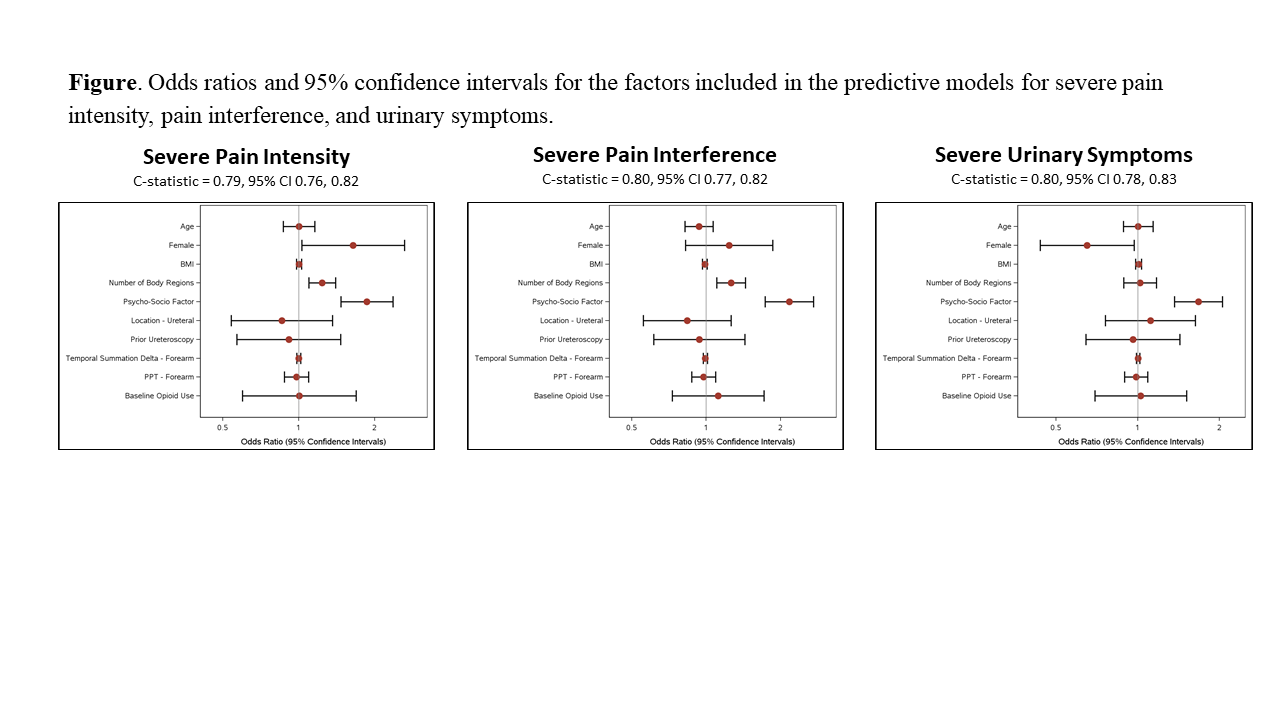Back
Introduction: In order to identify patients most likely to benefit from strategies to improve post-operative experiences, the Urinary Stone Disease Research Network developed models to predict severe pain and urinary symptoms after ureteroscopy (URS) for urinary stones.
Methods: The cohort included participants who underwent URS with ureteral stent placement for ureteral and/or kidney stones at 4 centers in the United States as part of the prospective STENTS study. We fit multivariable logistic regression models with generalized estimating equations for three outcomes: severe pain intensity (i.e., magnitude of pain), pain interference (i.e., pain disrupting daily activities), and urinary symptoms. Each outcome was defined as the top quartile of symptoms reported on post-operative days 1, 3, 5, and 7 after URS. In the model building process, we tested the following variables that were all measured before URS and stent placement: age, sex, BMI, number of body regions affected by pain, current depression, ureteral stone location, prior URS, opioid use, hypersensitivity to mechanical pain (pressure pain threshold), and pain facilitation (temporal summation).
Results: The study included 424 participants, of whom 6.6% were adolescents, 93.4% were adults, and 47% were female. Two-hundred twelve participants (50%) had kidney stones and 203 (48%) had ureteral stones as the indication for URS. Models that included sex, number of body regions affected by pain, and depression successfully predicted all three outcomes (Figure).
Conclusions: Pre-operative patient characteristics, particularly sex and psychosocial health, have good performance for predicting individuals who will experience severe pain and severe urinary symptoms after URS with ureteral stent placement. If validated in external cohorts, these models could be integrated into bedside practice to implement individualized pre-emptive strategies to improve post-surgical outcomes. SOURCE OF
Funding: NIH/NIDDK

Podium Session
Session: PD34: Stone Disease: Epidemiology & Evaluation II
PD34-04: Predictive Models for Severe Pain and Urinary Symptoms after Ureteroscopy with Ureteral Stent Placement from the USDRN STENTS study
Sunday, April 30, 2023
1:30 PM – 1:40 PM CST
Location: S502
- GT
Gregory E. Tasian, MD
Associate Professor of Urology and Epidemiology
The Children's Hospital of Philadelphia
Podium Presenter(s)
Introduction: In order to identify patients most likely to benefit from strategies to improve post-operative experiences, the Urinary Stone Disease Research Network developed models to predict severe pain and urinary symptoms after ureteroscopy (URS) for urinary stones.
Methods: The cohort included participants who underwent URS with ureteral stent placement for ureteral and/or kidney stones at 4 centers in the United States as part of the prospective STENTS study. We fit multivariable logistic regression models with generalized estimating equations for three outcomes: severe pain intensity (i.e., magnitude of pain), pain interference (i.e., pain disrupting daily activities), and urinary symptoms. Each outcome was defined as the top quartile of symptoms reported on post-operative days 1, 3, 5, and 7 after URS. In the model building process, we tested the following variables that were all measured before URS and stent placement: age, sex, BMI, number of body regions affected by pain, current depression, ureteral stone location, prior URS, opioid use, hypersensitivity to mechanical pain (pressure pain threshold), and pain facilitation (temporal summation).
Results: The study included 424 participants, of whom 6.6% were adolescents, 93.4% were adults, and 47% were female. Two-hundred twelve participants (50%) had kidney stones and 203 (48%) had ureteral stones as the indication for URS. Models that included sex, number of body regions affected by pain, and depression successfully predicted all three outcomes (Figure).
Conclusions: Pre-operative patient characteristics, particularly sex and psychosocial health, have good performance for predicting individuals who will experience severe pain and severe urinary symptoms after URS with ureteral stent placement. If validated in external cohorts, these models could be integrated into bedside practice to implement individualized pre-emptive strategies to improve post-surgical outcomes. SOURCE OF
Funding: NIH/NIDDK

